Table of content
Traders using Forex brokerage accounts are not confined to trading just the currency pairs. Many market participants also trade commodities in those platforms. Those securities do have their own special characteristics, which can have a significant influence on market prices.
Firstly, any thorough comparison of commodity prices to the currency exchange rates would conclude the former ones much more volatile. Therefore, in commodity markets, traders might experience some dramatic gains and losses more frequently than when trading with currency pairs.
The second important characteristic of trading commodities online is the fact that they do not pay any interest to their owners. This means that traders can not use carry trade strategies by holding on to long positions of commodities. On the other hand, depending on the US Federal Reserve interest rates, sometimes trades can earn some daily income by holding on to the short commodity positions.
The third essential thing to note here is that very often the relative real interest rates of the world’s major currencies play an important role in determining the future direction of commodity prices.
Finally, it worth noting that the exchange rates of some individual currencies are highly positively correlated with some commodity prices. This means that they tend to move in the same direction.
Trading Platforms for Commodities
If anybody asks a question, how do you trade commodities, the first thing which might come to mind is to purchase physical assets. For example, if an individual wants to trade precious metals, he or she can buy gold coins or bars and store them somewhere until one decides to sell those holdings.
The clear downside to this approach is the problem of storage. This is especially true for trading oil commodities since it can be very impractical and inconvenient to store dozens of barrels of oil. Storing gold and silver coins and bars at home can be much easier. However, the obvious problem with this is that there is always a risk of burglary, so it might not be the safest option.
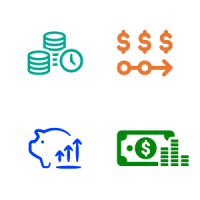
One solution to this problem is to store precious metals in bank vaults. Yet, one thing to mention here is that then the individual has to cover storage fees, which over a long time can add up to a significant amount. Also if a trader at some point wants to sell and get rid of those, it can not be done with just one mouse click. It might take some hours to send or bring those precious metals to their destination and receive payment.
Obviously, there are several ways to trade commodities online as well. For example, trading commodities futures can be one way to reduce the potential risk exposure due to market price fluctuations. The commodity futures contract represents an agreement to buy or sell a specific amount of commodity at a predetermined price on a specific date. Traders can use their Forex trading account as a platform for trading commodity futures.
It is an easy and convenient way of trading soft commodities and other types of similar assets. However, one downside here is that in most cases traders are charged with daily rollover fees for holding long positions with those. Therefore, this can be problematic for those traders who wish to take long term positions with commodities.
One alternative to futures trading is so-called the ‘Exchange Traded Funds’ (ETFs). Those assets operate just like ordinary funds, with the distinction that the main purpose of those is to mirror the movements of commodity prices. Here a small percentage of the management fee is factored in the market price of the security. However, traders do have to pay daily fees for retaining holdings in the fund.
Another upside to ETFs is the fact that traders do not have to pay any storage costs, which can add up to a considerable sum in the long term. At the same time, those assets are quite liquid. Therefore, if traders want to liquidate their investments and raise some capital in the process, they can do this in a short amount of time.
At this stage, the downside of all of the 3 options described above is that they do not pay any interest or dividends. Therefore, those solutions might not be so attractive for income investors.
Fortunately, there is another way to invest in the commodity markets, by investing in the shares of those companies which produce those types of raw materials. For example, instead of constantly waiting for the trading time for commodities, traders can purchase the stocks of oil-producing companies or gold mining firms. Here traders do not necessarily have to sell those shares in order to receive some payouts. Here investors have an option to hold onto those assets and receive quarterly or annual dividends. So this can be a very attractive option for income investors.
Day Trading Commodities with High Volatility
When analyzing commodity prices, the first thing which comes to mind is that they tend to fluctuate by a higher degree, then currency pairs. The possible reasoning for this is that when it comes to exchanging rates, they measure the relative value between two different fiat currencies.
It is possible that the two central banks of those respective currencies might be following a similar monetary policy. Or alternatively, the economies of those two currencies might have very similar levels of inflation or economic growth. So in case of those similarities, the relative value between those two assets might remain relatively flat over an extended period of time.
On the other hand, in the case of commodity markets, we are dealing with the actual price of one good or raw material. Therefore, this state of affairs makes those types of markets much more volatile.
To illustrate this, let us take a look at some examples. One way to get some idea about how does trading commodities work in comparison to that of Forex, let us have a look at this daily GBP/USD chart:
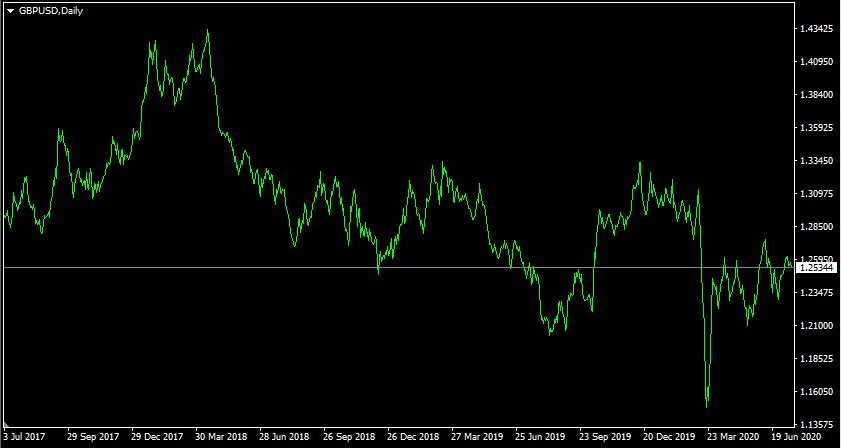
As we can see from the chart above, 3 years ago, the British currency was trading just above the $1.2950 level. Despite some notable degree of volatility, during the subsequent months of trading, the British currency has made some notable gains, eventually reaching a high point of $1.4330 in the middle of April 2018.
Despite this strong showing, from this point onwards the GBP/USD began its long term slide. This decline was gradual, however, the biggest drop came in March 2020, when the pound has collapsed all the way down to $1.1410. After the panic selling ceased, the situation stabilized and the British currency began to recover from some of its recent losses. After this recovery, by the middle of July 2020, the pair now trades close to $1.2530.
So in this case the 3-year low of $1.1410 and a 3-year high of $1.4330 in percentage terms is 25.6%.
Now let us compared this with the daily silver price chart, covering the same 3 year period:
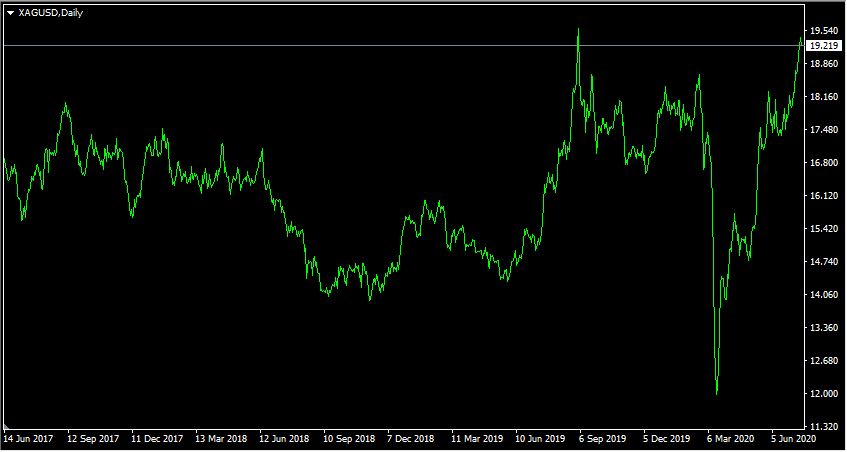
As the diagram above demonstrates, by July 2017, the silver price was hovering at around $16.70 level. The price moved sideways and remained relatively flat until June 2018. However, at that point, the price of this precious metal began to decline. This downward trend lasted until November 2018, by which time, the XAG/USD pair fell to $14.
Despite this setback, during the following months, the silver price recovered, eventually $19.60 by September 2019. After this point, the exchange rate stabilized and mostly moved sideways for some time. However, during the March 2020 stock market crash, the silver price dropped sharply, going all the way down to $12 level.
However, this sort of panic selling turned out to be temporary. During the subsequent period, the price of this precious metal recovered steadily and by July 2020, it has already reached the $19.20 level. So at this stage, the silver price is very close to returning to September 2019 highs.
In this case, the percentage differential between the 3-year low of $12 and a 3-year high of $19.60 is 63.3%. If we remind ourselves that the same indicator with the GBP/USD currency pair is at 25.6%, we can conclude that commodity prices can be at least twice as volatile, then the Forex market.
This means that trading physical commodities or ETFs gives market participants an opportunity to earn higher returns from their profitable trades. On the flip side of the coin, it is worth noting that a higher degree of volatility does increase the trader’s risk exposure. Therefore, the use of stop-loss or trailing stop orders is an even more essential part of how commodity trading is done.
Rollover Expenses with Commodity Trading
Another important thing to consider for commodity trading success is the fact that with Forex brokerage platforms, traders have to pay a daily interest in keeping the long positions overnight. So at this stage, one might ask a question: when it comes to interest swap dynamics of commodity trading, how it works?
Well, firstly it is very important to keep in mind that precious metals pay no interest. There is no central bank that controls the gold supply and sets interest rates for this asset. So let us consider the XAU/USD pair, the security which represents the gold price in the market. Because the precious metals pay no interest, the nominal interest rate of XAU is 0%. On the other hand, the US Federal Reserve does control the interest rates of the US dollar.
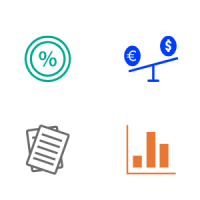
So why does a trader have to pay those expenses? Well, the explanation is very simple. If an individual opens a long XAU/USD position, then this means that the trader borrows money in US dollars in order to buy gold. So if the Federal Funds rate stands at 0.25%, then the interest rate differential between those two assets is 0.25%, in favor of the US dollar. Therefore, if a market participant wants to hold on to the long XAU/USD position, then he or she has to pay at least 0.25% per annual interest rate in order to do so.
Here it is worth noting that when a trader begins to trade commodities, brokers earn money not only from spreads but also on rollover commissions as well. So if the interest rate differential is 0.25%, then for coming up with accurate calculations, we have to add at least 0.1% in broker commissions. Therefore, in our example, for each day of keeping a long XAU/USD position open, a trader has to pay the 0.35% annual interest to the broker.
On the other hand, in some cases, traders can earn some income by opening and holding on to short XAU/USD positions. Since the March 2020 stock market crash, as the US Federal Reserve reduced rates back to 0% to 0.25% range, this is no longer profitable. However, back in the first half of 2019, when the Federal Funds rate was well above 2%, this was more profitable.
So for example, if the Federal Funds rate stands at 2.25%, then with the short XAU/USD position, a trader essentially borrows the gold, with 0% interest, to invest in the US dollar. Assuming the 0.1% commission of the brokerage company, a trader can earn a daily income, which will be the equivalent of 2.15% annual interest rate.
This is very helpful if traders want to take short positions with gold and silver prices. However, at this stage, the obvious question is: how can they avoid daily swap charges if they want to take long positions on those precious metals?
Well, one obvious way to achieve this is to make use of swap-free accounts. Many brokerage companies do offer those types of accounts, which are designed for those people, who wish to avoid rollover expenses. Brokers usually make up for those losses, by offering wider spreads or alternatively fixed amounts of commission per trade. Generally, this should not be very problematic for traders.
After all, for day trading purposes one does not have to pay any swap charges, because in this case, traders close all of their positions before the end of the trading day. However, if one intends to take a long term long position on precious metals, then a one-off expense in the form of spreads or commissions seems a very good deal. This seems a much more attractive option, then to pay a daily rollover fee for holding on to one’s positions.
Relationship Between Commodity Prices and Real Interest Rates
One thing which any detailed market analysis would reveal is that there is a significant degree of correlation between the real interest rates of the world’s major central banks and the prices of commodities.
In order to illustrate this, let us take an example of the gold price, by taking look at this daily XAU/USD chart:
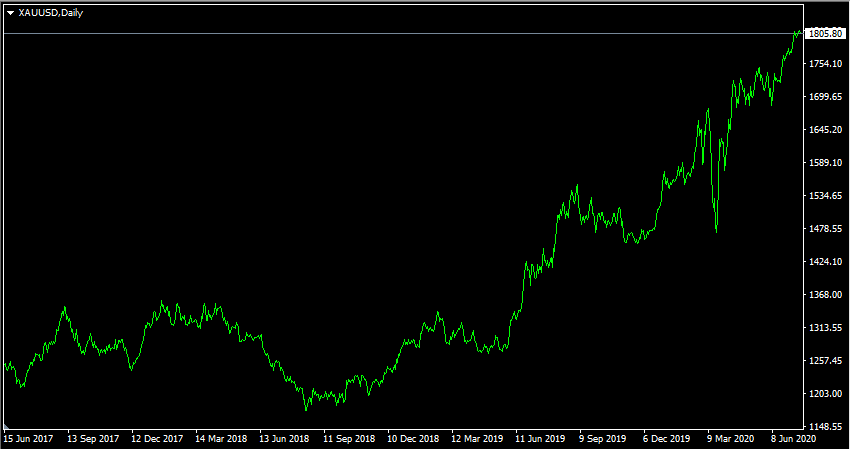
As we can see from the above image, 3 years ago, the gold was trading at $1,260 level. The US Federal Reserve delivered the first rate hike in a decade by December 2015, followed by another single increase in 2016. So by summer 2017, the real interest rates in the US were still deep in the negative territory.
As a result of this situation, the gold price made some gains, rising to $1,350 level by March 2018. However, as the nominal interest rates in the US kept rising, the prices of precious metals stagnated and then began to fall. The fact of the matter was that the US Federal Reserve delivered the 3 rate hikes in 2017, to be followed by 4 increases in 2018, taking rates within 2.25% to 2.50% range. This meant that after a full decade of negative real interest rates in the US, this indicator has briefly moved into the positive territory.
As a result of this development, the gold price plummeted to $1,173 level by August 2018. However, here it is worth noting that during the last rate hike cycle back in 2004-2006, the US Federal Reserve took the interest rates all the way up to 5.25%. However, this time the 2.50% turned out to be the high watermark. Already from the beginning of 2019, the financial commentators were already discussing the possibility of a rate cut.
This prediction has already materialized during August 2019, followed by two rate cuts during the year. At this stage, some people expected that the US Federal Reserve might be able to hold on to at least 1.5%. However, in response to the outbreak of the COVID-19 pandemic and the subsequent economic downturn, the policymakers in the US Federal Reserve decided to reduce rates back to 0% to 0.25% range.
Those decisions had a significant impact on gold prices. From June 2019, in anticipation of the first rate cut, the price of this shining metal has already started rising considerably. By the time of the last rate cut during March 2020, the gold price has already reached $1,675.
This was followed by a short-lived drop in the price, with XAU/USD falling all the way down to $1454 in response to the March 2020 stock market crash. However, this decline did not persist for long and the gold price simply returned to its long term uptrend, eventually reaching $1,805 by July 2020.
So as we can see from this example, the prices of precious metals tend to respond to the changes in the real interest rates. When the US nominal interest rates have risen consistently, the gold price stopped rising. As the US economy briefly moved into the positive real interest rate territory, the prices of precious metals declined considerably.
However, as soon as the US Federal Reserve started reversing this policy, the gold price has risen steadily over the months and even managed to get close to 2011 highs. Therefore, analyzing the latest real interest rates of the world’s major economies can give traders some valuable insight into the likely direction of commodity prices.
Why Real Interest Rates Affect Commodity Prices?
At this point, many people might wonder why real interest rates have such a significant influence on commodity prices. Well, in order to understand this, let us take an example of precious metals. It is a well-known fact that many investors consider gold and silver to be reliable hedges against inflation.
After all, for centuries many civilizations have used those for minting their coins. As long as the rulers of those countries kept the gold and silver contents of those coins pure, the population benefited from decades of stable prices. However, in times when those governments started to reduce the percentages of precious metal contents in those means of exchange, this was usually followed by a significant amount of inflation.
In modern times, for many investors gold and silver still retain this perception of a reliable store of value. This might not necessarily be the case in the short term, because of very significant fluctuations in the gold and silver prices. However, a considerable portion of market participants believed that in the long term, the prices of precious metals will rise in line with the inflation rate. There are obviously also those investors who do not believe that this is the case, however, most of them are not much interested in investing in commodities either.
Therefore, the majority of investors who invest in gold believe it to represent the ultimate protection from inflation. Now the obvious downside to investing in precious metals is the fact that they do not pay any amount of interest. So this can be problematic for income investors.
Consequently, one alternative to those investments is to invest in savings accounts, certificates of deposit (CDs), or government bonds. In order for those investments to be more attractive than precious metals, they have to pay higher interest rates, then inflation. If this is not the case, then over time, the investors will lose their purchasing power.
Example of XAU/USD
For the sake of more clarity, let us take an example of XAU/USD. By January 2019, the annual consumer price index in the United States stood at 1.6%. This means that by that time the average price of the basket of goods and services, as measured by the US Department of Labor and Statistics, was 1.6% higher than 12 months ago.
At the same time, the US Federal Funds Rate, as set by the US Federal Reserve, was within 2.25% to 2.50% range. So in this case investors had two alternatives. They could invest in precious metals and in the long term, protect their assets against inflation. Or alternatively, they could open a Certificate of Deposit or some other type of deposit account and earn up to 2.5%. This would fully cover the annual inflation cost of 1.6% and in addition, give 0.9% return to investors in real terms.
Obviously, there is some number of investors who always prefer to invest in precious metals, regardless of the circumstances. However, for the majority of market participants, the second option in this scenario would seem more appealing. This is because in this case, the projected return can be 0.9% higher than with gold investments.
The situation changes dramatically by March 2020. In response to the economic downturn, caused by the outbreak of the COVID-19 pandemic, the US Federal Reserve reduced rates back to 0% to 0.25% range. At the same time, according to the US Department of Labor and Statistics, the annual CPI in March stood at 1.5%. This means that if a market participant opened a 0.25% CD for a year, then the real projected return for this investment would be -1.25%, because of inflation. Therefore, in this case for many investors investing in precious metals might be more appealing, then losing their purchasing power to inflation. As a result, this increased the demand for gold and led to its long term appreciation.
Guide to Trading Commodities – Key Takeaways
- Commodities can be at least twice as volatile as currency pairs. This gives traders opportunities to earn potentially higher returns by trading those securities. On the other hand, it is worth noting that this also increases the potential downside risks of such traders. Therefore, the use of stop-loss or trailing stop orders are even more important when trading commodities. This can certainly help traders to guard against those risks and significantly reduce the amount of losses with losing trades.
- Commodities do not pay any interest, therefore their effective interest rates are 0%. This means that for holding on to long positions with such commodity pairs as XAU/USD, traders have to pay rollover charges to the brokerage company on a daily basis. On the other hand, depending on the central bank interest rates, in some cases, traders can receive a daily interest in keeping short positions on commodity pairs. One way to avoid rollover charges on commodity trades is to utilize swap-free accounts.
- The real interest rates in the major economies can have a very strong influence on commodity prices. This measure is calculated by subtracting the inflation rate from the nominal interest rate of a given currency. Therefore, in times when the world’s major central banks raise their rates above the Consumer Price Index (CPI) rate, this very often tends to depress the gold, silver and some other commodity prices. The opposite is also true, as the US Federal Reserve began cutting rates from Summer 2019, the gold prices made some significant gains.



